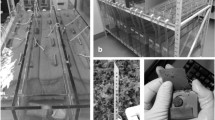Abstract
Aquarium experiments were performed to quantify the inorganic fraction of suspended particles deposited on the external surface of aquatic biota. The mass of suspended particles retained on the surfaces of microalgae growing on submerged substrates and the algal biomass were determined by comparing the scandium content of suspended material with that in algal communities. Scandium, a predominantly soil-associated trace element, has been used as a ‘tracer’ for the inorganic component of suspended particles, because this element is geologically ubiquitous in soils, and it is recognized that it cannot cross natural membranes of plants and other organisms. The algal biomass determined using the scandium content was compared with biomass values calculated using phytopigments as estimates of periphyton biomass. The results indicate that the suspended particle mass adhering to the external periphyton surface may accounted for up to 55% of the total mass collected on submerged artificial substrates.
Similar content being viewed by others
References
ANPA: 1999, ‘Le principali metodiche di campionamento ed analisi del particellato in sospensione in ambienti acquatici’, ANPA, Serie Documenti 9/1999, ISBN 88-448-0019-5, 140 p.
Bargagli, R.: 1995, ‘The elemental composition of vegetation And the possible incidence of soil contamination of samples’, Sci. Total Environ. 176, 121–128.
Becker, D. A. and Gills, T. E.: 1995, ‘Recent development in NIST botanical Srms’, Fresenius Z. Anal. Chem. 352, 163–165.
Beresford, N. A. and Howard, B. J.: 1991, ‘The importance of soil adhered to vegetation as a source of radionuclides ingested by grazing animals’, Sci. Total Environ. 107, 137–254.
Cordella, P. and Cavolo, F.: 1988, ‘Una proposta metodologica sul conteggio del fitoplancton’, Giornale Botanico Italiano 122(1), 92.
Dreicer, M., Hakonson, T. E., White, G. C. and Whicker, F. W.: 1984, ‘Rainsplash as a mechanism for soil contamination of plant surfaces’, Health Physics 46(1), 177–187.
Healy, W. B., Mccabe, W. J. and Wilson, G. F.: 1970, ‘Ingested soil as a source of microelements for grazing animals’, NZJ. Agric. Res. 13, 503–521.
Hinton, J.: 1992, ‘Contamination of plants by resuspension: a review, with Critique of measurement methods’, Sci. Total Environ. 121, 177–193.
Hinton, T. G., Stoll, J. M. and Tobler, L.: 1995, ‘Soil contamination of plant surfaces from grazing and rainfall interactions’, Journal Environ. Radioactivity 29, 11–26.
Li, J., Gerzabek, M. and Mück, K.: 1994, ‘An Experimental Study on mass loading of soil particles on plant surfaces’, Sonderdruck ‘Die Bodenkultur’ 45. Band, Heft 1, 15–24.
Lorenzen, C. J.: 1967, ‘Determination of chlorophyll and pheo-pigments: spectrophotometric equations’, Limnol. Oceanogr. 12, 343–346.
Markert, B.: 1995, ‘Sample preparation (cleaning, drying, homogenization) for trace element analysis in plant matrices’, Sci. Total Environ. 176, 45–61.
Newman, M. C., Mcintosh, A. W. and Greenhut, V. A.: 1983, ‘Geochemical factors complicating the use of aufwuchs as a biomonitor for lead levels in two new jersey reservoirs’, Water Research 17(6), 625–630.
Newman, M. C., Alberts, J. J. and Greenhut, V. A.: 1985, ‘Geochemical factors complicating the use of aufwuchs to monitor bioaccumulation of arsenic, Cadmium, Chromium, Copper And Zinc’, Water Research 19(9), 1157–1165.
Newman, M. C. and Mcintosh, A. W.: 1989, ‘Appropriateness of aufwuchs as a monitor of bioaccumulation’, Environ. Pollut. 60, 83–100.
O'Toole, J. J., Wessels, T. E. and Mc Leod, K. W.: 1981, ‘Trace element levels and their enrichment processes in terrestrial vegetation’, Journal of Plant Nutrition 3(1-4), 397–407.
Pinder III, J. E. and Mcleod, K. W.: 1988, ‘Contaminant transport in agroecosystems through retention of soil particles on plant surfaces’, Journal Environ. Qual. 17(4), 602–607.
Pinder III, J. E. and Mcleod, K. W.: 1989, ‘Mass loading of soil particles on plant surfaces’, Health Physics 57, 935–942.
Rafferty, B., Dawson, D. E. and Colg An, P. A.: 1993, ‘Seasonal variation in the transfer of 137 Cs and 40K to pasture grass, and its ingestion by grazing animals’, Sci. Total Environ. 145, 25–34.
Rafferty, B., Dawson, D. E. and Colgan, P. A.: 1994, ‘Soil and radiocaesium contamination of winter fodder’, Sci. Total Environ. 153, 69–76.
RESTORE Project: 1999, ‘Restoration strategies for radioactive contaminated ecosystems’, EC Contract FI4P-CT95-0021c, Final Report 1996-1999. Editors G. Voigt and N. Semioschkina, GSF-Forschungszentrum Für Umvelt Und Gesundheit, Germany. 83 p.
Sansone, U., Belli, M., Riccardi, M., Alonzi, A., Jeran, Z., Radojko, J., Smodis, B., Montanari, M. and Cavolo, F.: 1998, ‘Adhesion of water-borne particulate on freshwater biota’, Sci. Total Environ. 219, 21–28.
Smodiš, B.: 1992, ‘Reactor neutron activation analysis using the K0-standardization method. Part I: Theory and experimental considerations’ Vestn. Slov. Kem. Drus. 39(4), 503–519.
Summerling, T. D., Dodd, N. J. and Green, N.: 1984, ‘The transfer of strontium-90 and caesium-137 to milk in a dairy herd grazing near a major nuclear installation’, Sci. Total Environ. 34, 37–72.
Svetina, M., Smodis, B., Jeran, Z. and Jacimovic, R.: 1996, ‘Trace element in the water cycle of the alek valley, slovenia, using INAA’, Radioanal. Nucl. Chem. Articles 204, 45–55.
Thomas, A. J. and Martin, J. M.: 1982, ‘Chemical composition of river suspended sediment: Yangtse, Mackenzie, Indus, Orinoco, Parana And French Rivers (Seine, Loire, Garonne, Dor-dogne, Rhone)’, Mitt. Geolo.-Paläont. Inst. Univ. Hamburg. SCOPE/UNEP Sonderband, Heft 52, 555–564.
Utermöhl, H.: 1958, ‘Zur vervolkommung der quantitativen phytoplanktonmethodik’, Mitt. Int. Verein. Theor. Angew. Limnol. 9, 1–38.
Wetzel, R. G.: 1983, ‘Limnology’, 2nd Edition. Sanders College Publishing, 767 p.
Wyttenbach, A., Bajo, S., Tobler, L. and Keller, T.: 1985, ‘Major and trace element concentrations in needles of picea abies’, Plant Soil 85, 313–325.
Wyttenbach, A. and Tobler, L.: 1998, ‘Effect of surface contamination on results of plant analysis’, Commun. Soil Sci. Plant Anal. 29, 809–823.
Author information
Authors and Affiliations
Corresponding author
Rights and permissions
About this article
Cite this article
Sansone, U., Belli, M., Fernandez, J.A. et al. Testing Scandium Method to Quantify Suspended Particles Adhesion to the External Surface of Periphyton Communities. Water, Air, & Soil Pollution 141, 313–324 (2002). https://doi.org/10.1023/A:1021397827110
Issue Date:
DOI: https://doi.org/10.1023/A:1021397827110




